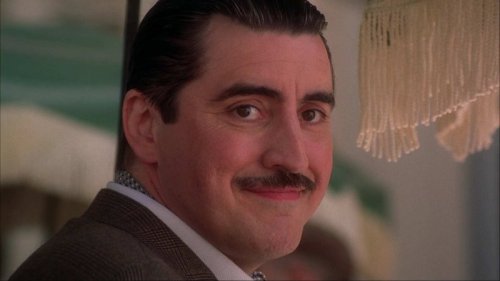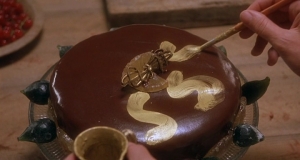The Delicious taste of
Chocolat: Movie Review
An exquisite taster
The film was released in 2000, and is a fine way to show how one charming single mademoiselle (and simply a good person) can change the conventional life in a village, for the better.
The movie is a joint US/UK production and was considered “One of the Best Pictures of the Year” by the Los Angeles Times.

It was the 2001 Oscar and Golden Globe nominee for Best Picture, Best Actress (Juliette Binoche), Best Supporting Actress (Judi Dench), Best Adapted Screenplay (Robert Nelson Jacobs) and Best Music (Rachel Portman).
SYNOPSIS
This romantic melodrama (and certainly a lovely comedy) is set in Flavigny, a French medieval city dating back to the 10th century, portraying the placid French town of Lansquenet where life is all peaceful and quiet.
Traditions are expected to be strictly followed, and the Church is its foundation stone — the life of the whole village revolves around it, as if events took place in medieval Europe.
Nothing seems to have changed since then, nothing much…
Anything that can disturb the order of things is considered a taboo, a threat, and is not welcomed by the mayor of the town, who himself is deeply religious.
Fortunately for him, so far things are going along their ordained path…
That is, until one cold winter day in 1959… a charming traveler is brought in with the sly northern wind, a wind of change… — a lady who’s going to settle in the village for a while… renting a patisserie and the apartment above it.
And from that moment on, nothing is ever going to be the same…
That very moment being the point-of-no-return, — Indeed.
 The time for change comes when she opens “The Maya Chocolatier,” starting her own business in what-one-would-consider the most inappropriate place for this of all — the orthodox village.
The time for change comes when she opens “The Maya Chocolatier,” starting her own business in what-one-would-consider the most inappropriate place for this of all — the orthodox village.
Neither is the timing perfect — with the upcoming season of the Big Lent, it becomes a major problem for the mayor. And he is going to deal with it, no matter the cost for his lovely, dear guest.
Even if it means losing her business.
But, by Easter, her business is still running, whereas for the mayor things are getting out of hand.
He tries to turn the villagers against her, saying that she’s indecent; she is “a bad influence.”
But Vianne manages to make friends with almost everyone in the village, in the process — changing their lives for the better, bringing vivid colors into the previously monochrome life. In the end, she turns out to be “a good influence” after all, including the one she had made on the mayor himself.
Initially, Comte de Reynaud (Alfred Molina) is strictly conservative, if not austere, with a condemning look strewn over his face.
Vianne herself is by no means conventional; she’s been travelling with her daughter, living in different places, all around the world: Andalusia, Vienna, and before that — Athens, — Pavia.
At night, she tells her stories not of princesses and princes on white horses — and in white carriages — but of “The Princess and the Pirates!”
And when the mayor, welcoming them into the community, kindly invites Vianne (Binoche) with her daughter (Thivisol) to Sunday Mass for worship, she thanks him for the invitation but says “they don’t attend”.
She then also asks him to call her Vianne, as she had never been married!
And as one of Anouk’s schoolmates asks the newcomer-girl about her father, she says that she sure has one; they just don’t know who he is.
None of this really fits into the Catholic framework of the conservative, provincial town they’re guests in.
As legend has it,
“Mother and daughter… are fated to wander from village to village… dispensing ancient cacao remedies… travelling with the wind, never settling down, just as Chitza’s people had done… for generations.”
No wonder that Vianne, Chitza’s daughter — now a mother herself — wandering from village to village, from country to country, from land to land, with her daughter, Anouk, has a knack for guessing people’s favorites. Not only is each chocolate she makes a piece of art in itself, having its own unique flavor, but she instantly knows whose favorite it is.
And thus far she is doing really well.
[That is] Until… a mysterious and handsome Gipsy Roux comes ashore the dull green waters of the river on his boat. He appears to be a ‘hard nut’ to crack. She just can’t seem to guess his favorite.

The handsome and brilliant Johnny Depp is at his most macho portraying Roux, playing the Spanish guitar gracefully.

And by some mysterious, vague, foggy chance of fate, he happens to play the very same guitar tune that Vianne’s mother used to sing to her as a lullaby in her distant childhood, — the tune a nostalgic echo of the faraway memories, mystically, masterfully mirrored back at her many years on.
But Roux is an outsider, and making friends with him means making enemies with the others; yet Vianne somehow, interestingly, even seems to welcome that challenge.
The mayor stands up to such defiance, eventually losing the battle. Feeling devastated, he finally lets things go, in the end finding himself strangely relieved.

Gradually, life in the province of Lansquenet changes unbelievably, enormously — the village is now free of the tranquillité, and Vianne — of her wanderer’s destiny. Roux is magically back in town, brought in with the southern summer breeze, and back with Vianne, to stay — she finally discovers his favorite… Josephine takes over Serge’s bar, turning it into… a new café. Pantoufle’s bad leg miraculously heals and ‘he hops off in search of new adventures.’
In the closing scene, we find the mayor’s ever-so-austere monument stretched in a fine and forgiving, lenient (if albeit somewhat indulgent), permissive and kind smile, symbolizing the Happy Ending, brilliantly mastered and achieved.

THE SCENERY
The scenery is stunning. Most mysterious… Inspiring. It feels as if the wind itself is an unspoken character, a ghostly figure in the story whose (outspoken) presence indicates a twist in the story, a major change yet to come — the change that can be felt in the frosty air… noticed in the slight motion of the cameras… almost palpable, tangible, sensed…
THE SCORE
The mysterious music — shifting from place to place, from scene to scene — is yet another, everpresent character of its own. Inspiring, enlightening and intriguing at times, it is a fusion of the Gypsie, the Spanish and the Ancient Mayan motives. Together, they create an incredible atmosphere, introducing into the story a spirit so unique and wonderful that certainly makes it one-of-a-kind, with a truly European feel to it.
THE CHARACTERS
The characters, too, are typically European and very natural.
THE OST
The original movie soundtrack is considered a masterpiece in its own right, earning the iconic Oscar-winning film composer Rachel Portman her second Grammy nomination for Best Score Soundtrack Album For A Motion Picture and a World Soundtrack Academy Award nomination (2001) for Soundtrack Composer of the Year (Chocolat, The Legend of Bagger Vance).
THE IMAGERY
The camera work is most brilliant by far! The imagery itself a haunting reminiscence of the medieval period…
No wonder it won the movie team an Art Directors Guild Award for Excellence in Production Design (Contemporary Film), a British Society of Cinematographers and a BAFTA Film Award nomination for Best Cinematography (Roger Pratt), Best Costume Design (Renee Ehrlich Kalfus), Best Production Design (David Gropman) and a nomination for Excellence in Period/Fantasy Film (Renee Ehrlich Kalfus) from the Costume Designers Guild Awards.
Beyond doubt, one could, truly, hardly find a French village more authentic to portray the conventional lifestyle of the French countryside in the whole of France.
A 2001 American Cinema Editors’ Eddie Awards nominee for Best Edited Feature Film (Andrew Mondshine),
“It’s built of such exquisite craft — the acting, the decor, the photography, the music — that to refuse it is to refuse the very sensations that draw us to art, romance and maybe even life itself.”
 So, if you get the chance, you should certainly go see this movie; it is a fine film in itself, simple yet mysterious. What it has to offer is the cast’s charming and natural performances, breathtaking scenery and those almost irresistible, vivid images of the Chocolatier. Surrender to its seductive taste and aroma. Plunge into the mysterious and legendary atmosphere of the European city covered in mist.
So, if you get the chance, you should certainly go see this movie; it is a fine film in itself, simple yet mysterious. What it has to offer is the cast’s charming and natural performances, breathtaking scenery and those almost irresistible, vivid images of the Chocolatier. Surrender to its seductive taste and aroma. Plunge into the mysterious and legendary atmosphere of the European city covered in mist.
Feel its aroma of m y s t e r y . . .
Discover the ancient Legend dating back to the Ancient Maya`s that still lives on in the 20th century. Feel the delightful taste of “Chocolat”.
For it’s quite worth tasting…
delivered by Stacey Mazur


